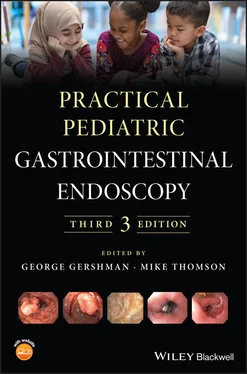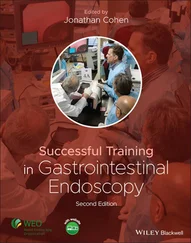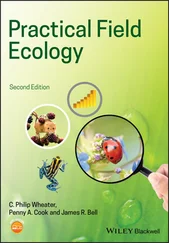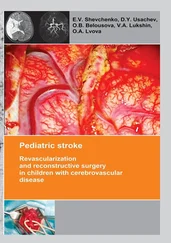A recent North American endoscopy clinical report proposed >90% ileal intubation rate as a quality metric for pediatric colonoscopy [6]. The pediatric colonoscopy certification criteria in the UK use terminal ileal intubation rates of ≥60% and cecal intubation rates of ≥90%, amongst other criteria, for certifying pediatric gastroenterology trainees to perform independent ileocolonoscopies ( www.thejag.org.uk).
Access to an electronic endoscopy reporting system is essential in all pediatric endoscopy units as this allows reliable and accurate data collection. There are other quality and safety outcomes which are important to monitor and review but due to a limited evidence base, it can be difficult to assign a standard, for example the minimum number of procedures required to maintain competence or unplanned admissions or procedures within a fixed time frame such as eight days of a gastrointestinal endoscopy or need for ventilation post gastrointestinal endoscopy performed under general anesthetic or unplanned use of reversal agents if sedation used. Other quality indicators may relate to the structure, process or staffing in a pediatric endoscopy unit.
Quality and safety indicators relating to structure can include access to age‐appropriate equipment, endoscopy reporting system, supportive anesthetic, pathology and radiology service with pediatric expertise, etc. Quality and safety indicators relating to process include having agreed policies such as for managing patients with diabetes, adherence to guidelines for endoscope decontamination, use of time‐out or WHO checklists pre‐procedure, an endoscopy user group that meets regularly, etc. Quality indicators relating to staffing include staffing levels and skill mix appropriate to the volume and types of procedures performed with pediatric competencies, identified medical and nurse leads for endoscopy with adequate managerial and clerical staff support, appropriate supervision of trainees, etc.
The National Endoscopy Database (NED), led by the Joint Advisory Group on GI Endoscopy (JAG), is a very exciting development in the UK. The NED is populated by data extracted automatically from the endoscopy reporting system at endoscopy services in the UK. It will make data available in user‐friendly outputs for clinicians, services and research purposes and enable improved quality assurance in endoscopy ( https://ned.jets.nhs.uk/KPI).
Development of quality improvement tools like the P‐GRS, a robust quality assurance process and the regular audit of performance against quality indicators that are clinically meaningful for pediatric endoscopy will help define their importance, measure performance variability against these indicators and in time allow pediatric endoscopy units to achieve and demonstrate the highest standards of quality and patient‐centered care through repeated cycles of measurement, intervention, and evaluation.
See companion website for videos relating to this chapter topic: www.wiley.com/go/gershman3e
1 1 Petersen BT. Quality assurance for endoscopists. Best Pract Res Clin Gastroenterol 2011, 25, 349–360.
2 2 Rex DK, Schoenfeld PS, Cohen J, et al. Quality indicators for colonoscopy. Gastrointest Endosc 2015, 81(1), 31–53.
3 3 Thakkar K, Holub JL, Gilger MA, et al. Quality indicators for paediatric colonoscopy: results from a multicenter consortium. Gastrointest Endosc 2016, 83, 533–541.
4 4 Singh HK, Withers GD, Ee LC. Quality indicators in paediatric colonoscopy: an Australian tertiary centre experience. Scand J Gastroenterol 2017, 52(12), 1453–1456.
5 5 Thomson M, Sharma S. Diagnostic yield of upper and lower gastrointestinal endoscopies in children in a tertiary centre. J Pediatr Gastroenterol Nutr 2017, 64(6), 903–906.
6 6 Kramer RE, Walsh CM, Lerner DG, et al. Quality improvement in paediatric endoscopy: a clinical report from the NASPGHAN endoscopy committee. J Pediatr Gastroenterol Nutr 2017, 65(1), 125–131.
9 e‐learning in pediatric endoscopy
Claudio Romano and Mike Thomson
 KEY POINTS
KEY POINTS
Distance learning facilitated by online means can achieve faster competence not only in lesion recognition but in learning technical skills prior to hands‐on training.
Examination of knowledge and appropriate application of endoscopic techniques may be a feature of future postpandemic assessment.
Advances in pediatric endoscopy have been assured since 1960. Over the past decades, the number of endoscopies for pediatric gastrointestinal disease has increased rapidly. Diagnostic and therapeutic applications increase at a rapid pace. Hands‐on courses are the primary learning tool, along with training in dedicated training units.
Recently, with the burgeoning of information technology, teaching procedures and modalities by which to provide infomration have changed. The introduction of e‐learning platforms has led to questions arround the appropriateness of teaching methods, design of the technological infrastructure, and the interaction of students with the technology. e‐learning can be defined as learning through electronic devices using technology as a medium for online interaction and to access information. e‐learning is used as one of the learning styles together with computer‐aided learning and remote learning. Pediatric endoscopists can now acquire detailed knowledge, techniques and experience in many pediatric endoscopic fields, including the role and indications of endoscopsy in pediatric gastrointestinal diseases; technique of upper gastrointestinal endoscopic examination; risk assessment; recognition of complications; application of sedation/GA; lesion recognition of gastrointestinal pathology; ideal ileocolonoscopy technique including resolution of loop formation.
Lesion recognition is an area which lends itself nicely to this technology as competency can be examined remotely. The techniques underlying competent endoscopy can be taught with videos in advance of hands‐on teaching and in this respect e‐learning or any platform allowing access to “distant” learning of techniques is superior to textbooks or other modalities. Furthermore, endotherapeutic techniques such as variceal and nonvariceal bleeding, gastrostomy insertion, balloon dilation of strictures etc. lend themselves to web‐based video learning of the techniques prior to hands‐on activity and training.
Various platforms have been devloped by organizations and societies such as ESPGHAN, ESGE, BSG, UEG, ASGE, etc, and these are readily available online.
The last and possibly most useful application of e‐learning is the ability to use it as an objective test of the user’s competency – particularly in lesion recognition and testing the individual’s knowledge generally of when and how to apply various techniques in pediatric endoscopy. It is envisaged that this may then contribute to any formative, summative, and ongoing assessments of a pediatric endoscopist’s ability.
Of course, many examples of lesions and best practice endoscopy also exist on the internet outside the formal concept of e‐learning.
See companion website for videos relating to this chapter topic: www.wiley.com/go/gershman3e
Читать дальше

 KEY POINTS
KEY POINTS







